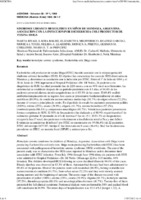Please use this identifier to cite or link to this item:
http://sgc.anlis.gob.ar/handle/123456789/155| Title: | Síndrome urémico hemolítico en niños de Mendoza, Argentina. Asociación con la infección por Escherichia coli productor de toxina Shiga | Other Titles: | Hemolytic uremic syndrome in children of Mendoza, Argentina: association with Shiga toxin-producing Escherichia coli infection | Authors: | Rivas, Marta Balbi, Laura Miliwebsky, Elizabeth García, Beatriz Leardini, Nelida Prieto, Mónica A. Tous, Mónica Chillemi, Germán de Principi, María E. T. |
Keywords: | Síndrome Hemolítico-Urémico;Niño;Escherichia coli;Toxina Shiga;Mendoza;Argentina | Issue Date: | 1998 | Journal: | Medicina (Buenos Aires) | Abstract: | Escherichia coli productor de toxina Shiga (STEC) ha sido asociado con la etiopatogenia del síndrome urémico hemolítico (SUH). El objetivo fue caracterizar los casos de SUH observados en Mendoza y determinar su asociación con la infección por STEC. Entre el 1º de Julio de 1994 y el 30 de Junio de 1996 ingresaron al Hospital Pediátrico «Dr. HJ Notti», 36 pacientes con diagnóstico de SUH. La edad promedio fue de 22.8 meses, con un 44% en el sexo femenino. La enfermedad se estableció después de un período prodrómico de 4.5 días, el 94.4% de los pacientes presentó diarrea siendo sanguinolenta en el 83.3% de los casos. El 69.4% recibió antibioticoterapia antes de su ingreso. Los casos se presentaron fundamentalmente en niños eutróficos (88.9%), de condición socioeconómica media-baja (91.7%) de origen urbano (72.2%), durante el verano y principios de otoño. En el período de estado los pacientes presentaron palidez (100%), edema (25%), anuria (38.9%), oliguria (41.7%), anemia hemolítica (97.2%), trombocitopenia (86.1%) y compromiso neurológico (41.7%). Veinticinco pacientes presentaron formas completas de SUH. El 50% de los pacientes fue dializado y el 88.9% requirió transfusión de sedimento globular. El promedio de díss de internación fue de 15.1. El 91.7% de los pacientes recuperaron la función renal, dos pacientes evolucionaron a insuficiencia renal crítica y uno fallecio. Evidencias acumulativas de infección por STEC se encontraron en 19 (86.4%) de 22 pacientes. STEC del serotipo 0157:H7, biotipo C fue detectado en 8 casos (36.4%). Stx2 fue la citotoxina prevalente en STEC, en materia fecal (STMF) y anticuerpos a-Stx. Hemolytic uremic syndrome in children of Mendoza, Argentina. Association with Shiga toxinproducing Escherichia coli infection. Shiga toxin-producing Escherichia coli (STEC) has been associated with pathogenesis of hemolytic uremic syndrome (HUS) worldwide. The aim of the present study was to characterize the HUS cases reported in Mendoza and to determine their association with STEC infection. From July 1994 through June 1996 thirty-six patients with HUS were admitted to Hospital Pediátrico «Dr. HJ Notti» (Mean age 22.8 ± 14.9 months, 44% females). The children developed HUS following an acute diarrheal illness in 94.4% of the cases. Bloody diarrhea was observed in 83.3% of them. Antimicrobial therapy had been administered to 69.4% of the patients. Most of the patients were well-nourished (88.9%), belong to middle-low socioeconomical condition (91.7%), from urban areas (72.2%) and they were mostly assisted during summer and the beginning of autumn. The acute stage of the disease occurred with presentation of pallor (100%), edema (25%), anuria (38.9%), oliguria (41.7%), hemolytic anemia (97.2%), thrombocytopenia (86.1%) and neurological involvement (41.7%). Twenty-five of them presented the full clinical syndrome. Peritoneal dialysis were performed in 50% and packed blood cell transfusion in 88.9%. The mean days of hospitalization was 15.1 ± 9.2 [rangte 1-32]. A 91.7% of the patients recovered renal function, two developed chronic renal failure and one died. Cumulative evidence of STEC infection was found in 19 (86.4%) of 22 HUS patients. STEC 0157:H7, biotype C was found in 8 (36.4%). The prevalent Stx type was Stx2 in STEC, free fecal Stx (STMF) and Stx-neutralizing antibodies (a-Stx). In Mendoza, as in the rest of Argentina E. coli 0157:H7, biotype C, Stx2 producer is the most frequently detected pathogen in HUS cases. |
Description: | Fil: Rivas, Marta. ANLIS Dr.C.G.Malbrán. Instituto Nacional de Enfermedades Infecciosas; Argentina. Fil: Balbi, Laura. Hospital Pediátrico Dr. Humberto J. Notti; Argentina. Fil: Miliwebsky, Elizabeth. ANLIS Dr.C.G.Malbrán. Instituto Nacional de Enfermedades Infecciosas; Argentina. Fil: García, Beatriz. Hospital Pediátrico Dr. Humberto J. Notti; Argentina. Fil: Tous, Mónica I. ANLIS Dr.C.G.Malbrán. Instituto Nacional de Enfermedades Infecciosas; Argentina. Fil: Leardini, Nelida. ANLIS Dr.C.G.Malbrán. Instituto Nacional de Enfermedades Infecciosas; Argentina. Fil: Prieto, Mónica A. ANLIS Dr.C.G.Malbrán. Instituto Nacional de Enfermedades Infecciosas; Argentina. Fil: Chillemi, Germán M. ANLIS Dr.C.G.Malbrán. Instituto Nacional de Enfermedades Infecciosas; Argentina. Fil: de Principi, María E. T. Hospital Pediátrico Dr. Humberto J. Notti; Argentina. |
URI: | http://sgc.anlis.gob.ar/handle/123456789/155 http://www.medicinabuenosaires.com/revistas/vol58-98/1/suremicohemolitico.htm |
ISSN: | 0025-7680 | Rights: | info:eu-repo/semantics/openAccess Creative Commons Attribution 4.0 International License |
| Appears in Collections: | snrd Publicaciones INEI |
Files in This Item:
| File | Description | Size | Format | |
|---|---|---|---|---|
| Medicina(Buenos Aires),1998,58(1),1–7.pdf | Artículo en español | 60.06 kB | Adobe PDF |  View/Open |
Page view(s)
937
checked on Dec 22, 2025
Download(s)
392
checked on Dec 22, 2025
Google ScholarTM
Check
This item is licensed under a Creative Commons License


